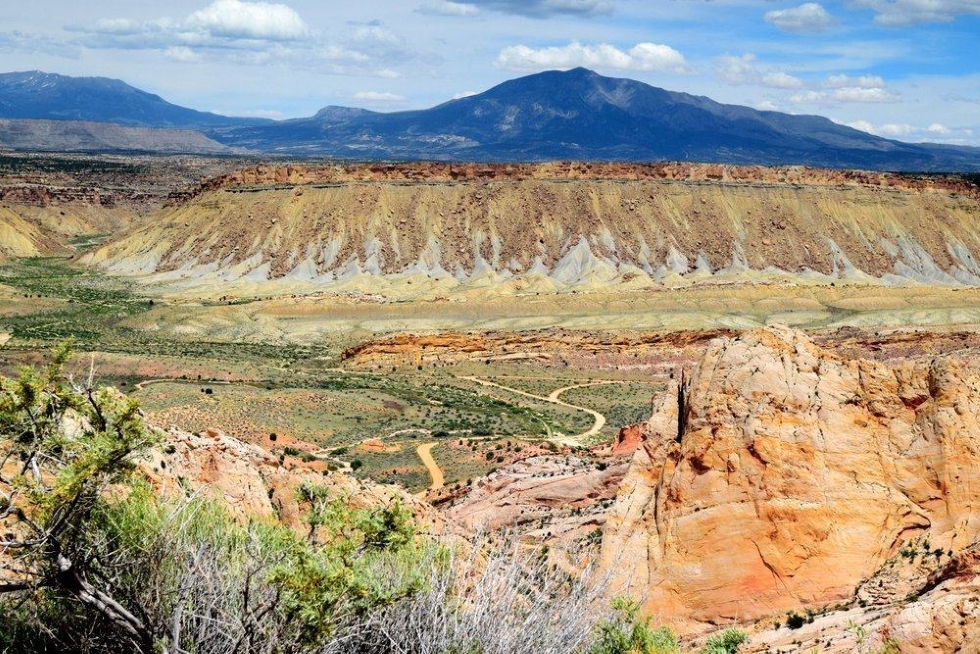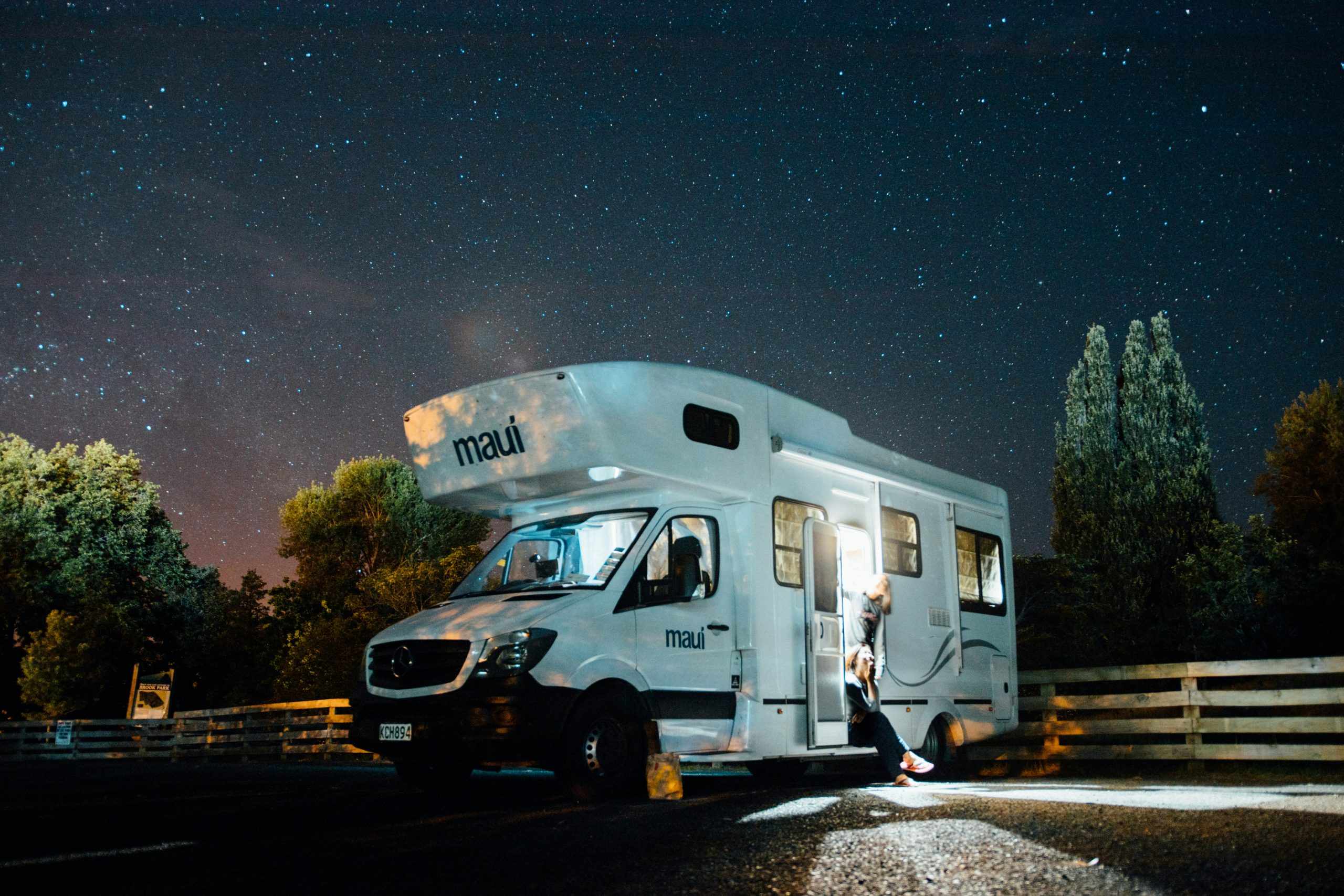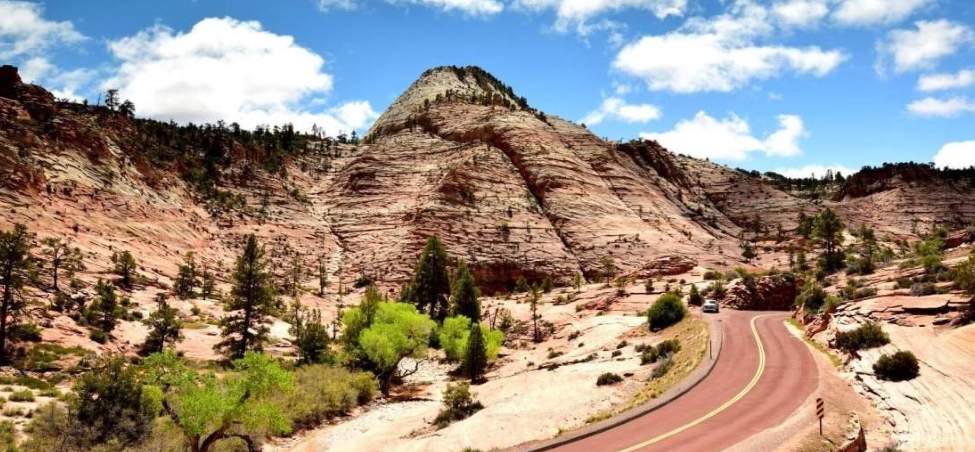The National Parks and the National Highways have long had an intimate relationship. When the National Parks service was established in 1916, one of their primary objectives was to provide public access to the nation’s parks. In the past, railways were the primary way to see the great parks of the west, but the number of automobiles in America was skyrocketing. By 1924, the parks service had a strong program of road building underway to make the nation’s parks fully accessible by automobile.
The following five road trips are all absolutely amazing experiences. I’ve ordered them from least challenging to most challenging. Some of the coolest experiences are best tackled with a 4-wheel drive vehicle, preferably one with good clearance. This is one reason why I like the flexibility of a truck and trailer RV. But even if you travel in a motorhome, you can easily rent a good 4WD vehicle for a day or two of outback adventures!
Mt. Carmel Highway
Zion National Park is a wonder of stone, water, and sky. Most of the park’s roads are now limited to bus traffic, but visitors to the park can still drive the Mt. Carmel Highway. And a good thing too, because it has to be one of the most spectacular drives in the US. If you start from the park headquarters, you wind your way up a steep switchback that gives you spectacular views of the river valley. Some find the road a little frightening, but it is smoothly paved and not especially narrow. If Mt. Carmel Highway is too much for you, the rest of this guide is probably not your cup of tea.
Once you have made it up the paved switchback, you enter the Mount Carmel Tunnel. It was the longest in the country as of its completion in 1930. Due to a large number of RVs that drive Mount Carmel Tunnel, and how narrow it is, they only allow traffic to flow one direction at a time. Thus, you may have a bit of a wait at either end. Still, the scenery while waiting for your turn is breathtaking, so make the best of it.
Once you get through to the other side, you are in for a show of geology like no other in the world. Incredible stone formations are everywhere you look. The variety of colors, shapes, and textures is simply jaw-dropping. You can either take the whole drive in one go, or you can stop at the many pullouts and go for a walk amidst this wonderland of stone. I highly recommend the latter. There are a number of trails, but in most places you can simply climb up on the rocks and explore. All said the driving will only take an hour or two. Take the road both ways to see as many cool sights as possible.
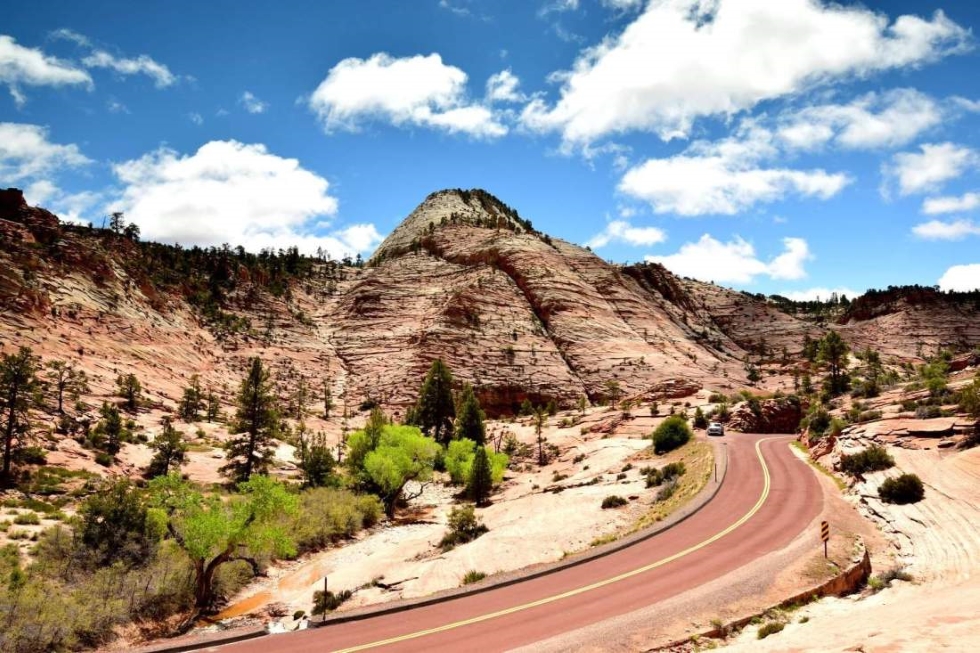
Going to the Sun Road
Glacier National Park is a scenic wonderland, especially in high summer. If you go there, you absolutely need to drive Going to the Sun Road. Many of the park’s key sites are located along it, but the drive itself is one of the park’s greatest attractions. The full drive is 50 miles long and will take at least 2 hours. This could be longer during busy times of the year. Parts of the road are open all year long, but the full road is typically only accessible from late June through October.
The road winds up into the mountains of Glacier, and the higher you go, the more you can see. Most of the mountains are covered in alpine forests, but there are also beautiful meadows, sheer rock cliffs, waterfalls, and plenty of wildlife. All along the road, there are places you can stop and simply take in the grandeur of nature. There are three major visitors centers, one on each end, and one at the highest point, Logan’s Pass.
I recommend striking out just around sunrise and making your way to Logan’s Pass to do some hiking and exploring. The trail that winds up into the mountains from there is phenomenal both for its scenery and wildlife. But you want to go early because during peak season the parking lot fills up quickly. It’s also a fantastic spot for stargazing.
Be aware that there are size limits for RVs on Going to the Sun Road. 21′ is the maximum length and 10′ the maximum height, so only small RVs can take the trip.
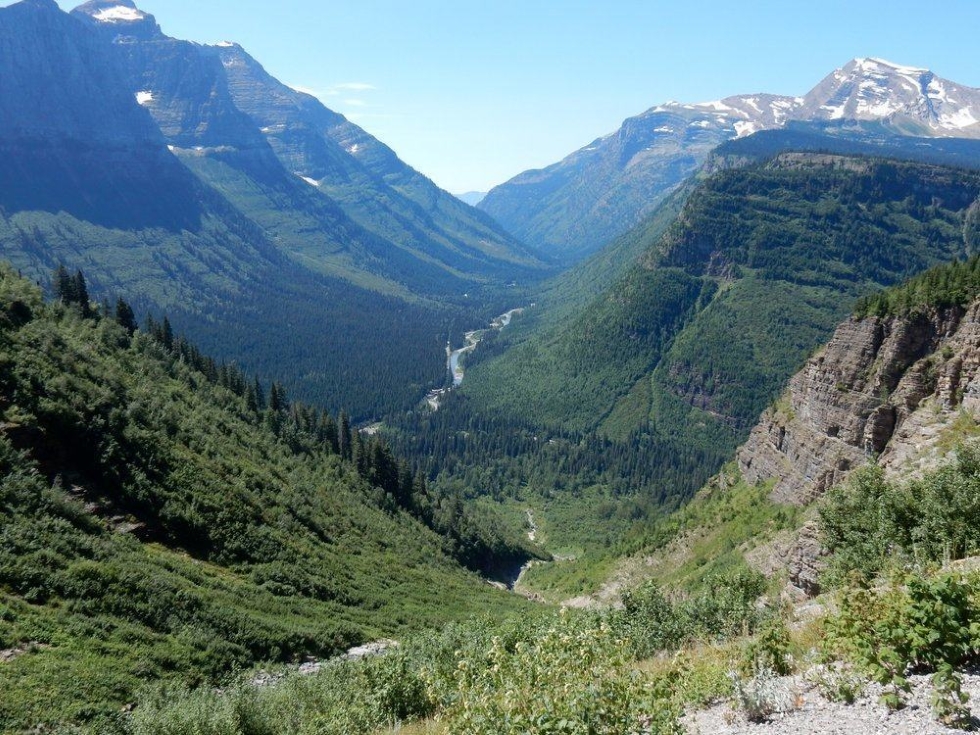
Burr Trail Road
Burr Trail Road spans two national parks — Grand Staircase-Escalante and Capitol Reef. The first half of Burr Trail is paved and you can easily drive it in an RV. The second half is a dirt road and you will need a regular car or truck to drive it. You don’t need 4WD or high clearance, but you should avoid the dirt section after a heavy rain as it can become impassable when muddy.
The paved section is an incredible drive through a winding canyon. It was originally created for driving cattle through the reef. Today, it gives you access to Deer Creek campground and simply makes for a spectacular drive. The location is often used to film car commercials due to its beauty and wonderfully curvy topography. It really is the kind of road you dream about driving on. There are plenty of places you can pull over and do some exploring.
If you stick it out for the dirt trail, get ready for some awesome views! The Burr Trail Road ends with the spectacular Burr Trail Switchbacks, which drops 800 ft. in about a mile. From the top, it’s not really clear there is a road leading down. Basically, someone had the bright idea of carving a dirt road into a cliffside. The view from the top is stunning, as is the view every inch of the way down. That said, if you are driving it you will be very focused on staying on the road and a bit less on the view. It is not for the faint of heart.
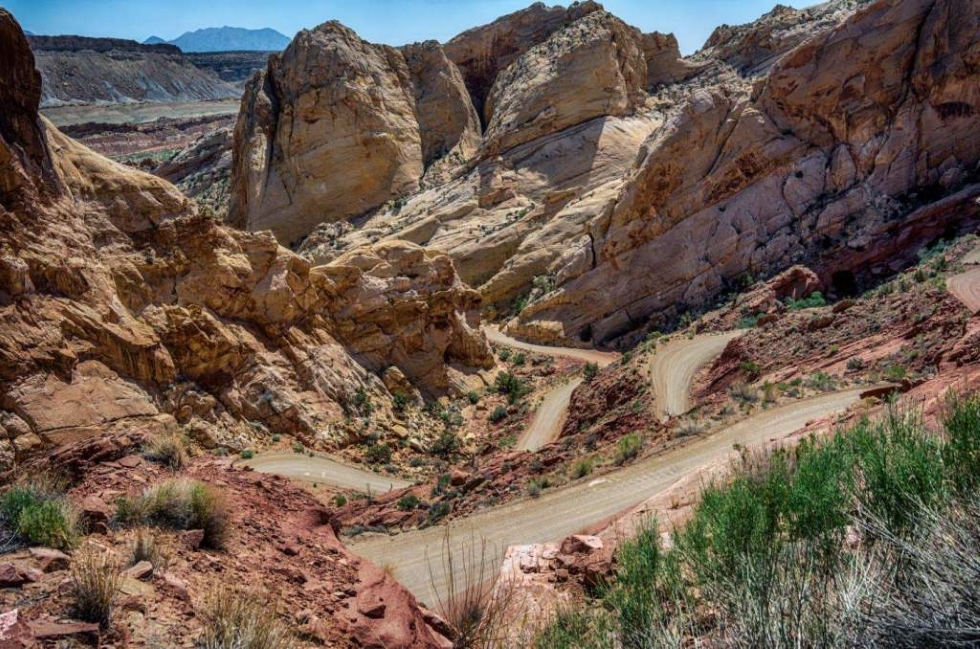
Titus Canyon Road
Titus Canyon — in Death Valley National Park — is all dirt, all the time. If you want to go on this adventure, you need a car with good clearance and preferably 4WD. It also helps if your vehicle isn’t especially large, as the road is often narrow. Make sure you check with the rangers to find out the road conditions before you head out and be aware, this is a one-way trip. Fortunately, the way back will be on nice paved roads in the park. This is a remote area in one of the hottest and driest places on Earth with limited to no cell phone service, so come prepared!
The road starts as a narrow dirt trail through the desert scrub. This leads into hill country surrounding the park where you will drive past some truly incredible desert rock formations. Here, you will head up into the hills on a narrow and often rocky road. It’s a bit like Zion East, but considerably scarier. After gaining a fair bit of elevation, the trail starts to wind back down through a narrowing valley. Here you will be navigating narrow switchbacks, torn between watching the road carefully — which you should do — and ogling at the breathtaking scenery — also worthwhile. Along the way, you can stop and visit abandoned mining towns from the days when copper was king in this area.
The valley narrows as you descend until finally, you enter Titus Canyon proper. Here the road winds its way past sheer rock cliffs rising hundreds of feet, just a few feet from either side of your vehicle. It is a surreal experience unlike any other I’ve had driving. I had the feeling that there was no way that I should be in a car in that location, yet there I was. As you go, the canyon does open wider, but the walls only get taller and the view more amazing until finally, you exit out into Death Valley proper. It is not a long drive, but it will take at least 3 hours as you will be going very slowly and very carefully.

White Rim Trail
This is perhaps the ultimate adventure road trip for the national park enthusiast. White Rim Trail is a feature of Canyonlands National Park. It is a dirt road that circles around Island In the Sky, a huge plateau in Canyonlands. The road is 100 miles long, and while that might not seem especially long, it is a rough dirt track on which you will be driving slowly and carefully. You will need a 4WD vehicle, a backcountry permit, and some camping supplies. It is strongly recommended that you plan at least a two-day trip to make the full circuit. You might even plan for three days if you want to do some scenic hiking along the way. There are no rest stops, watering holes, or gas stations, so come prepared!
What you will find are some of the most spectacular badlands on earth and 100 miles of near-total solitude. Most visitors to the park don’t opt for an adventure this extreme. For those who do, it is a once in a lifetime experience they will never forget and a true national park driving adventure. Just remember that it is not a thing to be rushed or hurried. The longer you linger and the more you stop and explore, the more magical it will be.

Find your own adventure
These are the most amazing drives I’ve been on in my travels in national parks, though far from the only ones. Since our first experience in Death Valley on Titus Canyon Road, my wife and I eagerly seek these out of the way drives everywhere we go. Our first stop in any park is the ranger station to find out what’s open, and what’s worth checking out at that time of year. Even if you prefer the safety of paved roads, there are plenty of amazing road trips to be had in America’s national parks.
